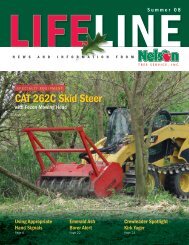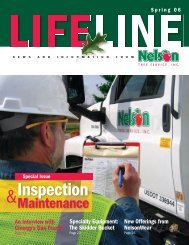LIFELINE
Winter 08 - Nelson Tree Service
Winter 08 - Nelson Tree Service
You also want an ePaper? Increase the reach of your titles
YUMPU automatically turns print PDFs into web optimized ePapers that Google loves.
F O C U S O N S A F E T Y<br />
Avoid Electrical Contacts with<br />
Proper Tree Trimming Techniques<br />
by Jeff Sachs, Safety Specialist, Region 466<br />
Over the previous several months the<br />
line clearance industry has experienced<br />
several disturbing incidents regarding<br />
electrical contact injuries and near<br />
misses. Electrical contact, directly or indirectly,<br />
is one of the worst types of injury a<br />
line clearance tree trimmer could sustain.<br />
As a Nelson Tree employee, you have<br />
been involved in safety stand-downs and<br />
received information on how to prevent these contact<br />
incidents. This is an extremely serious subject and, as<br />
part of Nelson Tree’s ongoing training, this article is<br />
devoted to providing more information on this topic.<br />
After investigating many of these electrical contacts,<br />
it has been determined that properly pruning a limb<br />
before cutting it, or placing a rope on the limb, could<br />
have prevented these electrical contacts.<br />
A proper job briefing is the best defense against<br />
breaking minimum separation requirements.<br />
The first and foremost factor in determining<br />
the potential of any limb breaking minimum<br />
separation is a thorough tree assessment<br />
that determines which limbs pose a<br />
risk before any work begins. Before<br />
contacting any limbs, ensure<br />
they are outside the minimum<br />
separation.<br />
PREVENT ELECTRICAL CONTACTS:<br />
• Use pruners to shorten limbs when there is growth<br />
inside minimum approach distance.<br />
• Use pruners to pull limbs back away from the<br />
conductors.<br />
• Use ropes to pull overhanging branches, and on<br />
branches leaning toward conductors that are too<br />
big to handle safely.<br />
• When roping, properly assess the weight of the limb<br />
and use an appropriate rope size and anchor point<br />
that is strong enough to support the limb.<br />
Proper crew leader supervision is critical<br />
in preventing limbs from contacting<br />
conductors. In the job briefing, the crewleader<br />
and the crew will determine the<br />
limbs that pose a risk, and the crewleader<br />
must provide direct supervision as these<br />
limbs are trimmed.<br />
Never slice cut limbs that have the potential to contact conductors! This<br />
is not the correct type of cut. Trimmers have little or no control of a limb<br />
once the slice cut is made. Slice cutting is only a safe technique when<br />
limbs are below the conductors. Instead, remove limbs using a hinge cut<br />
on the front side of the limb, then pull back with the pruner or a rope.<br />
7








